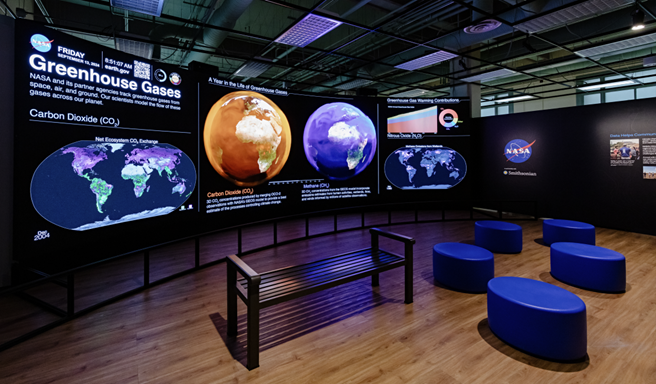A large Hyperwall—a giant video screen used to display NASA’s Earth Information Center data—will be the centerpiece of “NASA’s Earth Information Center at the National Museum of Natural History.” The Hyperwall in
Smithsonian and NASA Partner to Open Exhibition Exploring Ever-Changing Earth from Space and on the Ground

A large Hyperwall—a giant video screen used to display NASA’s Earth Information Center data—will be the centerpiece of “NASA’s Earth Information Center at the National Museum of Natural History.” James Di Loreto, Smithsonian.
The Smithsonian’s National Museum of Natural History will open “NASA’s Earth Information Center at the National Museum of Natural History”—a 2,000-square-foot exhibition showcasing the dynamic forces and processes that are constantly shaping the planet—on Tuesday, Oct. 8. The immersive exhibition will feature graphics, interactives and an enormous, state-of-the-art 32-foot-long, 12-foot-high curved video wall presenting awe-inspiring visualizations of Earth. These dramatic displays are created with data captured by satellites and sensors monitoring Earth and reveal how natural forces, climate change and human activities continuously alter the planet. The exhibition will remain on view through 2028.
“In addition to exploring the cosmos, Smithsonian and NASA researchers analyze how our own planet is changing in real time,” said Kirk Johnson, the Sant Director of the National Museum of Natural History. “It is a tremendous honor to partner with NASA to bring this dynamic view of Earth to museumgoers and connect people more deeply with their home planet.”
NASA Administrator Bill Nelson said, “NASA is a climate agency. With our fleet of over two dozen Earth-observing satellites and instruments, NASA leverages our unique vantage point in space to observe our planet and help those on the ground take action. The Earth Information Center provides easily accessible, readily usable, and scalable information on Earth’s environment and climate, and this new Earth Information Center at the Smithsonian National Museum of Natural History will bring NASA's data to even more people.”
Researchers at both the Smithsonian and NASA strive to understand how the Earth works. But they often look at the planet from different vantage points. Smithsonian researchers usually take a boots-on-the-ground approach, studying ecosystems and geological processes up close in the field or through museum collections. NASA scientists often zoom out for a view of the entire planet, using satellites and other sensors to create a detailed snapshot of the Earth from space.
NASA’s space-based perspective launched the Earth Information Center (EIC). Building on data collected by NASA and other federal agencies, the EIC provides a live look at Earth’s conditions by tracking factors like global temperature, precipitation, sea level rise and the atmospheric levels of carbon dioxide and other greenhouse gases. This information helps policy makers, researchers and communities understand and respond to the impacts of climate change, biodiversity loss and natural disasters.
The EIC collects data that is not only vast but also detailed, and NASA scientists and engineers have developed exciting ways to make these extensive datasets easily digestible as well as visually dazzling. Utilizing a giant video screen called a Hyperwall, the EIC displays its data through colorful visualizations and striking imagery. These displays capture a constantly changing Earth by modelling weather patterns, tracking temperature fluctuations, mapping the spread of wildfires and retraction of ice sheets.
A large Hyperwall will be the centerpiece of the museum’s new exhibition. In addition to data visualizations, the Hyperwall also will play rotating short-form videos that highlight how researchers and stakeholders around the planet are using this data to tackle environmental issues. One such video explores how the Smithsonian’s National Zoo and Conservation Biology Institute scientists utilize GPS collars and satellite data to monitor efforts to reintroduce the scimitar-horned oryx, a relative of antelopes that was long extinct across its native range in northern Africa. The video also presents how the Jane Goodall Institute has used similar satellite data to create a habitat map for chimpanzees and support habitat recovery across central Africa. Another video focuses on long-term efforts by the Smithsonian Tropical Research Institute’s Forest Global Earth Observatory (ForestGEO) network to track forest cover by co-leading GEO-TREES, a consortium of established forest inventory networks around the world. Dense patches of forests absorb carbon dioxide and other greenhouse gases from the atmosphere; ForestGEO and GEO-TREES's measurements can be used to help calibrate efforts to monitor carbon storage and sinks with satellites in space. More short-form videos will be added to the Hyperwall display while the exhibit is on view at the museum.
In addition the Hyperwall, museumgoers will have the opportunity to explore exhibit information panels and interact with touchscreen displays. One interactive display allows visitors to track the route of NASA satellites as they collect data on Earth. A model of one such satellite, NASA’s Surface Water and Ocean Topography satellite, will hang above the exhibition.
About the National Museum of Natural History
The National Museum of Natural History is connecting people everywhere with Earth’s unfolding story. It is one of the most visited natural history museums in the world. Opened in 1910, the museum is dedicated to maintaining and preserving the world’s most extensive collection of natural history specimens and human artifacts. The museum is open daily, except Dec. 25, from 10 a.m. to 5:30 p.m. Admission is free. For more information, visit the museum on its website, blog, Facebook, X (formerly Twitter) and Instagram.
# # #
Note: Members of the news media interested in a press preview of the exhibition are asked to contact the museum’s press office for more information, using the contact information included in the header of this press release.
SI-313-2024
Ryan Lavery
202-633-0826
Jack Tamisiea
202-633-0218
Randall Kremer
202-360-8770
Note to editors: Photos illustrating content and topics covered in the new exhibition for news media use can be accessed via Dropbox here (password: earth).










